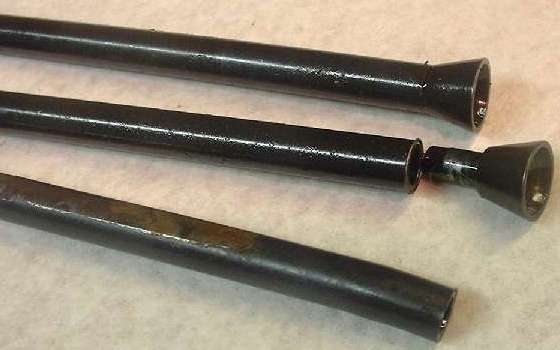The MGA With An Attitude
TUBULAR PUSHRODS - CRANE CAMS INC -- FT-001

Part: Crane 905-0004 Pushrod, set of 8
Supplier: Crane Cams, Inc.
Vendor: Local speed shop
Purchased: December 1999
In Service: Feb 26, 2000 - 49,733 mi
Failed: May 26, 2000 - 52,162 mi
Service life: 2,429 miles
The picture should tell the story pretty well. These Crane Cams Inc tubular pushrods just fell apart in operation. The top cups and bottom ball ends are (supposed to be) press fit inside of the length of hollow tubing. This is a good idea to reduce mass and inertia in the valve train in order to increase possible engine operating speed without without encountering valve float. Unfortunately they seem to be lacking in execution of design or quality of manufacture. The end pieces were snug in place when the parts when new. After a little more than 2000 miles of use, mostly street driving with a few autocross dates mixed in, 15 of the 16 end pieces were loose enough to rotate with fingers, and half of them could be pulled out of the tubes just as easily.
The one part at bottom of the picture is bent, which may be attributable to an intake valve which broke at the keeper end. It is not known for sure which was cause and which was effect, but two more of the intake valves failed in the same manner within a span of 15 months and 22,000 miles, so I suspect the broken valve was the cause of the bend in the pushrod (but having nothing to do with the loose ends).
These parts were installed in a MGA 1500 engine as parts recommended for use with a Crane Cams 342-0010 "mechanical camshaft for use with solid lifters". They were accompanied by the recommended Crane 99884-8 heavy duty valve springs. These "long" pushrods are used with the "short" tappets from the MGB 18V engine (which gives even more reduction of mass in the valve train).
With the vibration and beating these parts encounter in normal operation at several thousand RPM engine speed, I'm not terribly surprised that the joints failed. As a career machine designer, it is my humble opinion (in perfect retrospect) that the end joints of these parts should have been welded together for reliability to assure against this type of failure. This could be nicely done with laser or electron beam welding, which would of course add a little to the expense of manufacture.
Response from local speed shop: "Haven't heard of this problem before. Take it up with Crane for a warrantee claim."
Response from Crane Cams Inc: (No response).
Recommendation: Don't bother using these parts until such time as this problem is resolved.
|
